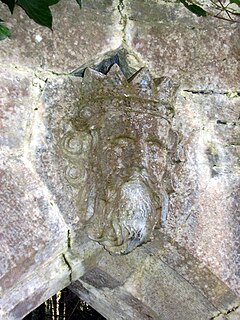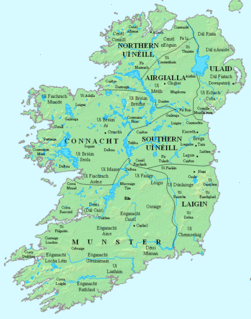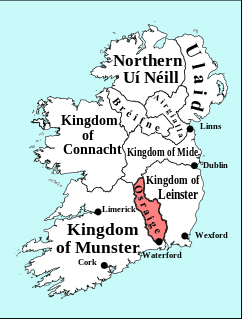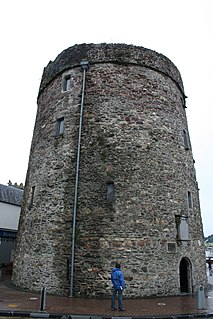Colman Ua Clasaigh (died 661) was an Irish tutor and poet.
Colman was "the tutor of Cumméne Fota", Bishop of Clonfert, who died in November 661. The Annals of the Four Masters reproduce three versed that he composed in memory of Cummene:
The same annals, in an immediately succeeding note, state "St. Colman Ua Cluasaigh, died."

Ruaidrí mac Tairrdelbach Ua Conchobair was King of Connacht from 1156 to 1186, and High King of Ireland from 1166 to 1198. He was the last High King of Ireland before the Anglo-Normans invaded Ireland.

Uí Fhiachrach Aidhne was a kingdom located in what is now the south of County Galway.
Magnus McConnor Roe O'Conor was king of Connacht in Ireland. He was a member of the Clan Murtagh O'Conor. He ousted his brother.

The kings of Osraige reigned over the medieval Irish kingdom of Osraige from the first or second century AD until the late twelfth century. Osraige was a semi-provincial kingdom in south-east Ireland which disappeared following the Norman Invasion of Ireland. A number of important royal Ossorian genealogies are preserved, particularly MS Rawlinson B502, which traces the medieval Mac Giolla Phádraig dynasty back through Óengus Osrithe, who supposedly flourished in the first or second century. and one in the Book of Leinster. Recent analysis of ninth and tenth century regnal succession in Osraige has suggested that in peaceful times, kingship passed primarily from eldest to youngest brother, before crossing generations and passing to sons and nephews.
Toirdhealbhach Ua Briain, anglicised Turlough O'Brien, was King of Munster and effectively High King of Ireland. A grandson of Brian Bóruma, Toirdelbach was the son of Tadc mac Briain who was killed in 1023 by his half-brother Donnchad mac Briain.

Colmán of Lindisfarne also known as Saint Colmán was Bishop of Lindisfarne from 661 until 664.
Cumméne Find was the seventh abbot of Iona (657–669). He was the nephew of a previous abbot, Ségéne and great-nephew of Lasrén. It was during Cumméne's abbacy that the Northumbrians decided against adopting the Gaelic dating of Easter at the Synod of Whitby in 664, resulting in the loss of control of the Ionan offshoot Gaelic church at Lindisfarne. In 664, the last Gaelic abbot/bishop of Lindisfarne, Colmán, resigned his post and returned to Iona. It was during Cumméne's abbacy that the Book of Durrow was first produced, although this probably happened at Durrow itself, rather than Iona. Cumméne is known to have visited Ireland in 663, perhaps on a tour of daughter houses.

The Ó Dálaigh were a learned Irish bardic family who first came to prominence early in the 12th century, when Cú Connacht Ó Dálaigh was described as "The first Ollamh of poetry in all Ireland".
Colmán Rímid was an Irish king who is included in some lists as a High King of Ireland. Colmán was the son of Báetán mac Muirchertaig, also considered to be a high king, and belonged to the Cenél nEógain branch of the northern Uí Néill. He ruled in Ailech from 578 to 602. His byname Rímid meant "the Counter".
Óengus mac Colmáin Bec was an Irish king. He was the King of Uisnech in Mide from 618 to 621. He belonged to the southern Uí Néill. According to the genealogies, he was a son of Colmán Bec, son of Diarmait mac Cerbaill. The later Caílle Follamain traced their descent through Óengus.
Guaire Aidne mac Colmáin was a king of Connacht. A member of the Ui Fiachrach Aidhne and son of king Colmán mac Cobthaig. Guaire ruled at the height of Ui Fiachrach Aidne power in south Connacht.
Colmán Már mac Diarmato was an Irish king, son of Diarmait mac Cerbaill. Early sources and older scholarship distinguish two sons of Diarmait, Colmán Már and Colmán Bec, although some scholars suggest there was only one Colmán mac Diarmato. There are some traces of Colmán Bec in the Irish annals, but so far as Colmán Már is concerned only his putative death is recorded.
Báetán mac Muirchertaig, also Baetán Bríge, was an Irish king who is included in some lists as a High King of Ireland. He was the son of Muirchertach mac Muiredaig, also considered a high king. He was a member of the Cenél nEógain branch of the northern Uí Néill. He ruled in Ailech from 566 to 572.
Events from the 7th century in Ireland.
Ivar of Limerick, died 977, was the last Norse king of the city-state of Limerick, and penultimate King of the Foreigners of Munster, reigning during the rise to power of the Dál gCais and the fall of the Eóganachta.
The Abbot of Clonard was the monastic head of Clonard Abbey, which is in modern-day County Meath, Ireland. The abbey was founded by Saint Finnian in the early sixth century. After the death of Saint Finnian, the abbots bore the title "Comarbai Finnéin". However, the title was ambiguous, since it may refer to the abbots of Moville, County Down, founded by Finnian nepos Fiatach. The abbots of Clonard were sometimes called 'coarbs of Finnian and Mo Cholmóc'. Until the early twelfth century, a few of the abbots and some others at Clonard Abbey were consecrated bishops, but this did not necessarily mean they were bishops of Clonard, since the diocese of Clonard was not established until the Synod of Rathbreasail in 1111.
Maine mac Cearbhall, great grandson of Niall of the Nine Hostages, died 531 or 538. The brother of Diarmait mac Cerbaill, future High King of Ireland. Maine's great grandfather was Niall of the Nine Hostages, making Maine an Ui Neill. Maine's descendants according to the Book of Ballymote were called Cenel Maine.

Ivar of Waterford was the Norse king of Waterford from at least 969 until his death in the year 1000, and also reigned as King of Dublin, possibly from 989 to 993, and certainly again for less than a year between 994 and 995, returning after his expulsion from the city in 993 by Sigtrygg Silkbeard, who would expel him for good the next time.
Muireadhach Ua Dubhthaigh was an Archbishop of Connacht, in Ireland.
Saint Fiachra was the Bishop of Armagh, Ireland from 548 to 558.